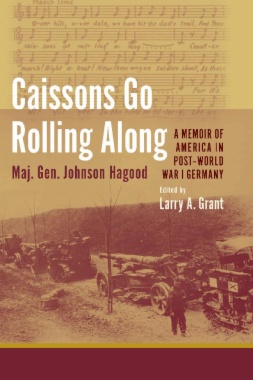Major General Johnson Hagood (1873-1948) was one of South Carolina's most distinguished army officers of the twentieth century. An artillerist and a scholar of military science, Hagood became a noted expert in logistics and served as the chief of staff of the Services of Supply in World War I Europe. Taken from Hagood's wartime journal, Caissons Go Rolling Along describes his artillery brigade's march into Germany in 1918, the wartime devastation, his impressions of the defeated enemy and occupied territories, and his tour of the recent battlefields in the company of the commanders who fought there.
Written in a conversational style, the narrative focuses principally on Hagood's time in command of the Sixty-sixth Field Artillery Brigade following the armistice. The Sixty-sixth FAB was attached to the American Third Army, which later became the American occupation force in the Rhineland. Hagood recorded his impressions of the conditions in which he found his men at the end of the war and the events of a tour of the French, British, and American battlefields. More important, he set down a record of the devastation of the French countryside, the contrasting lack of suffering he found in Germany, the character of the Germans, and some predictions for the future.
"I have left the text as it was when we held these people at the point of the bayonet," he wrote in his preface years later. "The opinions we formed at that time are important because they were the basis of our action.... The scourge of the Great War took a heavy toll... and we Americans might as well keep in mind what we were fighting for." Hagood captures defining aspects of the American character at the close of World War I. He described a boisterous, optimistic people, sure of their new place in the world. Rome provided Hagood with an analogy for the new American empire, which he took for granted in his postwar memoir.
Completed during Hagood's lifetime but unpublished until now, Caissons Go Rolling Along is an engrossing portrait of war-torn Europe, a stark reminder of grim realities of the Great War, and a richly detailed look at the daunting task of occupying and rebuilding a defeated nation.
- Cover������������
- Title Page�����������������
- Copyright Page���������������������
- Table of Contents������������������������
- List of Illustrations����������������������������
- About������������
- Editorial Method�����������������������
- Preface��������������
- Introduction�������������������
- Chapter 1: Back with the Old Brigade: Armistice Day—Mailly-le-Camp—Haussimont—General Chamberlaine—Naval Guns—In Front of the Front—Prisoners of War—Étain—Metz—Marshal Pétain�������������������������������������������������������������������������������������������������������������������������������������������������������������������������������������
- Chapter 2: The Army Artillery: Visit to G.H.Q.—Luxemburg—Hotel Staar—66th F.A. Brigade—Blercourt—Getting Back to Normalcy—Brigade Mess—Robert
- Chapter 3: On the Move: Out of Blercourt into Esch—Welcomed by the Luxemburgers— The Grand Duchesse—Cost of Living High—Mertert—Peasant Life in Luxemburg—First Glimpse of Germany�����������������������������������������������������������������������������������������������������������������������������������������������������������������������������������������
- Chapter 4: Marching through Germany: Crossing the Frontier—Bitburg—The Count A. . . von A. . .n and His Wife—First Impressions Favorable—On to Hillesheim— America Crosses the Rhine—The Doctor’s Office���������������������������������������������������������������������������������������������������������������������������������������������������������������������������������������������������������������
- Chapter 5: Bassenheim: The Château—The Knights’ Hall—Extensive Gardens—Abundant Food—Well Trained Servants—Letter to the Burgomaster—General Hines at Neuwied—Christmas Eve among the Robber Barons— Over the Rhine at Coblenz�������������������������������������������������������������������������������������������������������������������������������������������������������������������������������������������������������������������������������������
- Chapter 6: Höhr-Grenzhausen: Journey’s End—Fish—Army Artillery Commander—Our Area— Command—Pottery—Billets—Brigade Commander’s Quarters— Servants—Office Space—German Prisoners��������������������������������������������������������������������������������������������������������������������������������������������������������������������������������������
- Chapter 7: Gott Strafe England—Und America Introductory—First Impressions—von Steuben—Ambassador Gerard—Hate—The Lusitania—Post War Attitude—Greeted with Flags—Servility—What are We Fighting For?
- Chapter 8: Squareheads: Our Attitude towards the Germans—Atrocities—Children— Schools—No Poverty—Motor Trucks—Precedence—First Division����������������������������������������������������������������������������������������������������������������������������������������������
- Chapter 9: Welfare Workers: Soldiers Want to See Some Skirts—Letter to Carter—Miss Waller and Mrs. Stevens—Y.M.C.A. Building—Shows—Y.M.C.A. Entertainers—Saving the Boxing Game—Chaplains as Managers— Selling Cigarettes—Gift Tobacco
- Chapter 10: The School at Trèves: Vocational Work—Dardanelles—Working on Hunches—Augustus Treverorum—Porta Nigra—The School—Politics Back Home�����������������������������������������������������������������������������������������������������������������������������������������������������
- Chapter 11: Belgium: Brussels—“Ouf! Ils Sont Partis!”—Louvain Victim of Frightfulness— Liège—Ludendorff’s Own Story��������������������������������������������������������������������������������������������������������������������������
- Chapter 12: Over the Battle Fields: Military Barriers—France and Germany—Area of the Somme, Marne and Meuse-Argonne—Order of Battle������������������������������������������������������������������������������������������������������������������������������������������
- Chapter 13: With the British: Vimy Ridge—General Morrison—Importance—Albert—Third Battle of the Somme—46th British Division—St. Quentin Canal— Bellenglise Tunnel—General Boyd—The Australians—Thiepval Heights—High Woods
- Chapter 14 Who Broke the Hindenburg Line?: The Thirtieth Division—Abbéville Agreement—Plan of Operation— How It Came Out—Citations�����������������������������������������������������������������������������������������������������������������������������������������
- Chapter 15: With the Americans Sedan—Stenay—Grand Pré—Amiens—Cantigny����������������������������������������������������������������������������
- Chapter 16 With the Americans (Cont’d.): Château Thierry—General Situation—Holding the Bridge—The Second Division—Who Signed the Chit?—Big Bertha—The Third Division—What Makes ’em Fight?�������������������������������������������������������������������������������������������������������������������������������������������������������������������������������������������������
- Chapter 17: With the French Soissons—First Visit to the Front—Chemin des Dames—Soissons’ Last Fight—Laon and Rheims—Verdun—The Human Soup Bowl— Guests of the French Government—The Big Battle—Au Revoir���������������������������������������������������������������������������������������������������������������������������������������������������������������������������������������������������������������
- Chapter 18: Homeward Bound: Heavy Snow—Hôtel Porta Nigra—Waffles and Syrup—Back in Beastly Germany—Chamberlaine’s Story—Shake-ups in the Brigade—Big News—Trip to Italy—Demonstration against Wilson—What about George Washington?—C’est Fini����������������������������������������������������������������������������������������������������������������������������������������������������������������������������������������������������������������������������������������������������
- Notes������������
- Selected Bibliography����������������������������
- Index������������
- About the Editor

